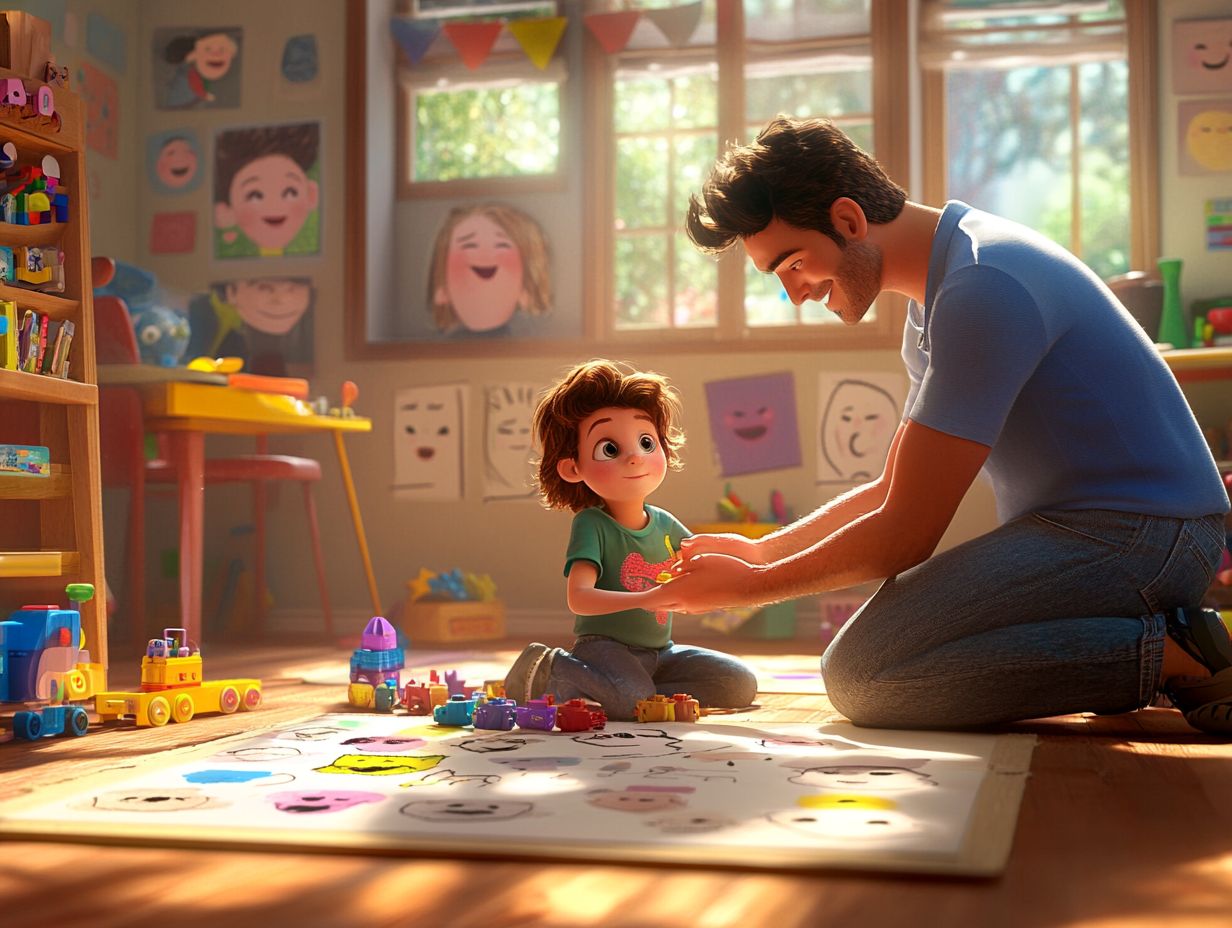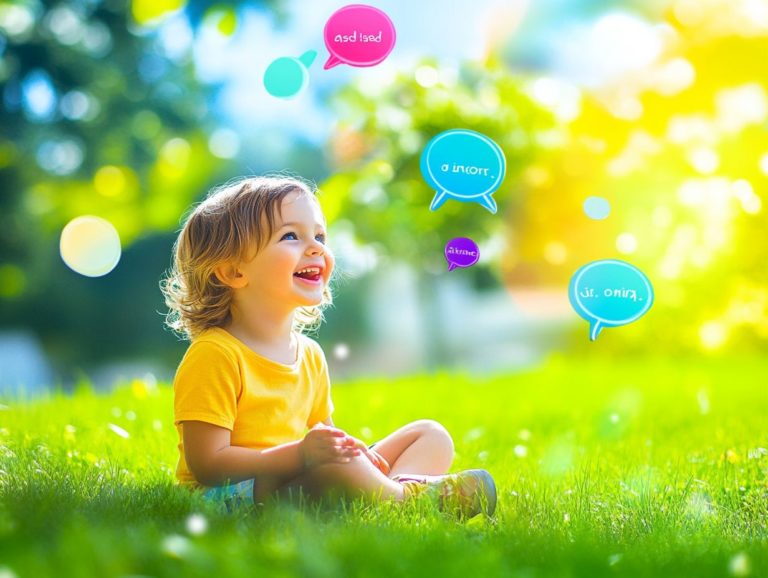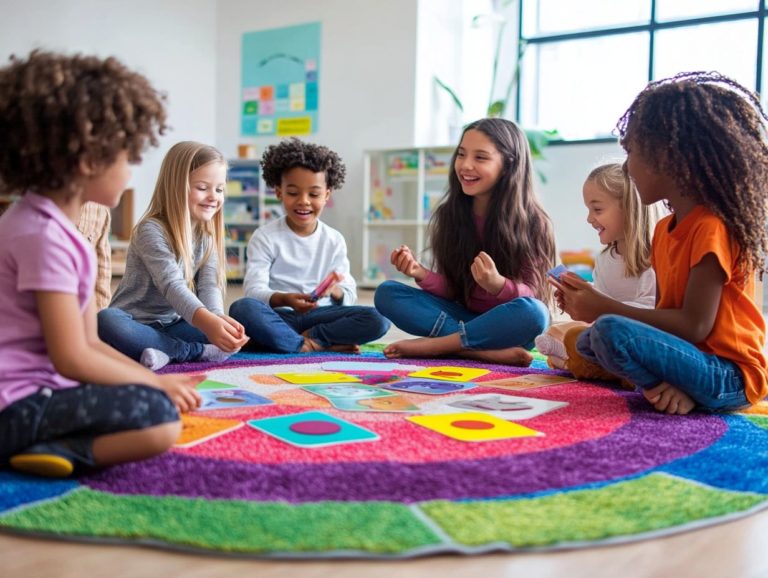Recognizing Your Child’s Emotions: A Guide
Understanding and recognizing your child’s emotions is crucial for nurturing their emotional development during the early childhood years. When you, as a parent or caregiver, are attuned to your child’s feelings, you foster an environment of trust, encourage healthy emotional expression, and support their ability to regulate emotions.
This discussion delves into the importance of acknowledging these primary and secondary emotions, offering you practical tips for recognition, and exploring the common feelings children experience. It provides you with strategies to help your child manage their emotions effectively, ensuring they blossom into emotionally intelligent individuals capable of healthy emotional reactions.
Here are the key points to remember about recognizing your child’s emotions.
Contents
- Key Takeaways:
- Why Is It Important To Recognize Your Child’s Emotions?
- What Are The Benefits Of Recognizing Your Child’s Emotions?
- How To Recognize Your Child’s Emotions?
- Recognizing and Supporting Your Child’s Emotions
- What Are The Common Emotions Children Experience?
- How To Help Your Child Manage Their Emotions? Insights on Emotional Regulation and Coping Skills
- 1. Teach Them Coping Strategies
- 2. Encourage Open Communication
- 3. Model Healthy Emotional Expression
- Nurturing Your Child’s Emotional Health
- Frequently Asked Questions
- What is the importance of recognizing my child’s emotions and emotional reactions?
- How can I tell if my child is experiencing a specific emotion, such as distress or anxiety?
- What should I do if my child is experiencing a negative emotion, such as sadness or anger?
- How can I teach my child to recognize and manage their own emotions and avoid not acknowledging feelings?
- What if my child has difficulty expressing their emotions, such as anger or shame?
- Can recognizing my child’s emotions prevent behavioral problems?
Key Takeaways:

- Recognizing your child’s emotions is important for building trust and connection with them, fostering a strong bond and empathetic behavior.
- Benefits of recognizing your child’s emotions include helping with emotional regulation, nurturing emotional intelligence, and promoting healthy expression of emotions.
- To recognize your child’s emotions, pay attention to non-verbal cues, listen and validate their feelings, and be aware of emotional triggers.
Why Is It Important To Recognize Your Child’s Emotions?
Recognizing your child’s emotions is essential for their emotional development, as it establishes a foundation for emotional intelligence and emotional regulation throughout their formative years. By validating their feelings, you create a nurturing environment that fosters a strong bond and encourages healthy emotional expression, which is crucial for their overall mental health.
Children who learn to understand their emotional experiences are more likely to develop effective coping skills and navigate social interactions. These abilities are vital for their overall mental health and well-being, especially during their childhood and cognitive development stages. This understanding empowers them to express themselves confidently and deepens the bond you share with them, enriching your parent-child relationship.
What Are The Benefits Of Recognizing Your Child’s Emotions?
Recognizing your child’s emotions offers a wealth of benefits, including fostering emotional regulation, building a strong bond, and enhancing emotional validation. Each of these significantly contributes to their evolving emotional well-being and behavioral development, laying the groundwork for long-term emotional health.
When you actively acknowledge and respond to your child’s emotional experiences, you play a crucial role in instilling vital coping skills and self-regulation. These skills help children manage distress effectively and navigate the complexities of relationships and social interactions, which are crucial for their overall emotional health.
1. Builds Trust and Connection
Building trust and connection with your child is one of the most significant outcomes of recognizing their emotions. This directly correlates to their sense of security and emotional well-being, fostering a secure attachment. When you validate their emotions, your child feels understood and accepted, which strengthens your bond and contributes to their emotional growth.
This trust empowers them to express their feelings openly, knowing their emotional experiences will be acknowledged and respected. To nurture this relationship, you can practice active listening by giving your full attention during conversations, maintaining eye contact, and responding thoughtfully.
For instance, when your child expresses frustration over a difficult school assignment, a simple acknowledgment like, “It sounds like you’re really struggling with this, and that’s okay,” can make a significant difference. Engaging in follow-up questions encourages your child to delve deeper into their feelings, creating an environment where emotions are not only recognized but valued.
Over time, these interactions can pave the way for long-term emotional health, allowing your child to grow into an emotionally resilient adult capable of forming meaningful bonds.
By understanding and addressing your child’s emotions, you set the stage for a lifetime of emotional intelligence and resilience.
2. Helps with Emotional Regulation
Helping children with emotional regulation is essential for their overall development and well-being. As they learn to manage emotional triggers like frustration, anxiety, sadness, and anger, recognizing their emotions becomes crucial.
You can teach them effective coping skills and self-soothing behaviors that empower them to navigate their feelings and respond to challenges constructively. This skill helps them manage their feelings today and in the future.
To assist your children, start by openly discussing emotions and emotional reactions during everyday moments. Acknowledge their feelings when they re upset about a lost toy or anxious about a school event.
Encourage them to express how they feel, whether verbally or through art and play activities. Create an environment where their emotions are validated rather than dismissed.
Modeling calming techniques, like taking deep breaths or using positive self-talk during stressful situations, provides them with tangible examples to observe and emulate.
Establishing a consistent routine that includes time for reflection or mindfulness helps them learn to recognize and effectively manage their emotional responses, aiding their emotional development.
3. Encourages Healthy Expression of Emotions
Encouraging healthy expression of emotions is essential for helping your children develop emotional intelligence and problem-solving skills. By guiding them to articulate their feelings instead of suppressing or mismanaging them, you create an environment where they can thrive emotionally.
When you recognize and validate both positive and negative emotions, you establish a safe space for your children to share their experiences. This fosters a deep understanding of their feelings and enhances their communication skills.
This open dialogue empowers them to express their emotions appropriately and sets the foundation for emotionally healthy relationships and mental health.
To nurture this emotional growth, engage your children in activities like role-playing, storytelling, or arts and crafts. You can also play songs that reflect different emotional states.
These activities serve as wonderful outlets for self-expression and emotional validation. Employing techniques such as active listening, where you focus intently on what your child is saying, encourages them to share their thoughts without fear of being judged.
By balancing discussions about joyous moments with conversations about difficult experiences, you equip your children with the tools they need to navigate the complexities of emotions and social interactions.
Ultimately, this holistic approach fosters resilience, allowing them to embrace their emotions and respond to challenges with confidence, supporting their long-term emotional wellbeing.
How To Recognize Your Child’s Emotions?
Recognizing your child’s emotions requires a keen eye for their behaviors and non-verbal cues, coupled with a mindful approach to listening that validates their feelings.
As a parent, you hold a pivotal role in attuning yourself to your child s emotional landscape. This involves interpreting body language, observing facial expressions, and noting shifts in tone of voice.
By staying aware of emotional triggers and being mindful of your own reactions, you can foster a nurturing environment. This encourages your child to express themselves and feel understood, aiding their emotional and cognitive development.
Recognizing and Supporting Your Child’s Emotions
1. Pay Attention to Non-Verbal Cues

Paying attention to non-verbal cues is crucial for you as a parent to accurately recognize your child’s emotions. Many feelings are expressed through body language, facial expressions, and overall demeanor.
For example, a furrowed brow or a downturned mouth can indicate sadness, while crossed arms and a tense posture may signal anger or frustration. You should also be on the lookout for signs of anxiety, such as fidgeting or avoiding eye contact, which can reveal your child’s inner turmoil.
By understanding these specific cues, you can engage in meaningful conversations and provide support that is tailored to your child’s needs.
Responding with empathy whether it s offering a comforting hug or simply acknowledging their feelings can help your child feel validated and understood, mitigating emotional invalidation. This creates a space where children can express their emotions freely, promoting their emotional health.
2. Listen and Validate Their Feelings
Listening to and validating your child’s feelings is a powerful way to acknowledge their emotions. It affirms their experiences and helps them feel truly understood. When you actively listen and recognize what your child is feeling, you create an environment of emotional safety that encourages open communication and emotional support.
This kind of validation not only assists your child in expressing their feelings but also fosters emotional intelligence and well-being over time.
By employing techniques like maintaining eye contact and nodding, you can demonstrate genuine engagement in the conversation. For example, when your child expresses frustration about a peer’s behavior, you might respond with, “It sounds like you felt really hurt when that happened. Can you tell me more about it?” This kind of phrasing invites a deeper discussion, reinforcing that their feelings truly matter.
Reflecting back what your child says, such as, “I hear you saying that you re angry,” can open the door for further exploration of their emotional landscape. This gives them the power to express themselves freely, knowing they won t be judged.
3. Be Aware of Triggers
Understanding the emotional triggers in your child s environment is essential for grasping their emotional experiences and responses. Children often react intensely to specific situations be it changes in routine, social interactions, or external stressors which can lead to emotional outbursts or distress.
By identifying these triggers, you can help your child develop effective coping strategies, preparing them to handle difficult situations better.
To initiate this process, keep the lines of communication open with your child. Encourage them to articulate their feelings and identify which situations make them uncomfortable. Consider maintaining a journal to track their moods alongside daily events; this can help you uncover patterns related to their emotional responses.
Establishing a stable routine can also minimize unexpected changes that trigger anxiety. Teaching mindfulness and relaxation techniques gives your child the power to manage their emotions. Offering positive reinforcement when they handle their triggers well can significantly enhance their emotional resilience.
Engaging in play-based activities can create a safe space for your child to explore their feelings, allowing them to express themselves freely.
What Are The Common Emotions Children Experience?
Children experience a wide range of emotions anger, sadness, fear, joy, and beyond each contributing significantly to their emotional growth and comprehension of the world around them.
As a parent, recognizing these emotions is essential! It gives you the power to support your children through their diverse emotional experiences and guide them in expressing and managing their feelings in healthy ways.
By understanding these emotions, you can also pinpoint potential behavioral issues and nurture your child’s emotional intelligence, paving the way for a more resilient and emotionally aware individual.
1. Anger
Anger is a common emotional reaction in children, often arising from feelings of frustration, disappointment, or perceived injustice. When your child experiences anger, it s essential to help them grasp the underlying causes of this emotion. Equip them with ways to manage their feelings. By offering appropriate coping strategies and validating their feelings, you can guide them toward healthier expressions of anger.
To manage anger effectively, it s important to identify specific triggers that might provoke your child’s outbursts, such as overwhelming situations, conflicts with peers, or unmet expectations. Teaching self-soothing techniques, like deep breathing or counting to ten, gives your child the power to regain control when they feel overwhelmed.
Encouraging open communication about their feelings creates a safe environment for your child to express their emotions, allowing them to articulate their frustrations without resorting to explosive behaviors. By facilitating discussions around anger and its root causes, you can significantly aid your child in developing the ability to bounce back from challenges and a deeper understanding of themselves.
2. Sadness
Sadness is a common emotion that children experience, often triggered by loss, disappointment, or shifts in their surroundings. As a parent, recognizing your child’s sadness is essential; it enables you to offer the emotional support they need and validate their feelings.
By teaching coping skills and encouraging open conversations about sadness, you can give your child the power to build resilience and gain a deeper understanding of their emotional landscape. It’s important to understand the sources of this sadness whether it s the loss of a beloved pet, the departure of a friend, or a difficult situation at school. This awareness allows you to respond in a way that truly meets their needs.
By creating an atmosphere where feelings can be openly discussed, you help your child process their emotions in a healthy, constructive way. It s crucial to approach these moments with empathy and patience, as children may require time to express what they’re feeling.
Guiding them through healthy grieving processes like sharing stories or reminiscing about what was lost can foster emotional healing and development.
3. Fear
Fear is a completely natural emotional reaction in children, often tied to the unknown or situations that appear threatening, which can amplify feelings of anxiety. It s crucial for you, as a parent, to recognize and validate these fears because brushing them off can lead to emotional invalidation and even greater distress.
By helping your child confront their fears and nurturing their emotional intelligence, you can profoundly impact their coping strategies and overall emotional well-being. Creating a supportive dialogue allows you to foster open discussions about fears, encouraging your child to articulate their feelings and understand that it s perfectly okay to feel afraid.
Gradual exposure to these fears whether through storytelling, role-playing, or exploring new places together can build their confidence and help reduce apprehension over time. This approach not only gives your child the power to face their anxieties but also strengthens the bond between you as you navigate these experiences together.
With your encouragement and positive reinforcement, you can turn fear into a powerful opportunity for growth and resilience.
4. Joy

Joy is a vibrant and uplifting emotion that you can often witness in children during moments of happiness, achievement, or connection with others. These joyful moments are fantastic chances to connect with your child!
When you take the time to celebrate their joyful expressions whether through heartfelt verbal affirmations, fun celebratory rituals, or simply sharing a laugh you not only validate their feelings but also demonstrate the importance of emotional expression. Such interactions nurture positive emotional growth, equipping your child with the skills to recognize and articulate their emotions effectively.
This supportive environment lays the groundwork for strong interpersonal relationships and fosters resilience, giving your child the power to navigate life’s ups and downs with optimism and confidence.
5. Disgust
Disgust is an emotional reaction that you might notice in children when they encounter unpleasant stimuli, whether it s related to taste, smell, or social situations. By understanding and recognizing these feelings of disgust, you can engage more effectively with your child, as this emotion often ties closely to their personal boundaries and preferences.
When you discuss feelings of disgust, you re providing your child with the tools to articulate their emotions, helping them develop a richer understanding of their emotional landscape.
This awareness opens the door to honest conversations, encouraging your child to express their discomfort and preferences freely, without fear of judgment. Recognizing these feelings is vital; it allows you to validate your child’s emotional experiences, making it clear that it’s entirely acceptable to dislike certain situations or stimuli.
By establishing boundaries around these feelings, you not only protect your child but also give them the power to make choices that honor their emotions.
In doing so, you guide your child in navigating social dynamics, ultimately teaching them to respect their own emotional responses while also being mindful of the feelings of others.
6. Surprise
Surprise is an emotion that you may notice your child frequently encounters in response to unexpected events, whether they are delightful or challenging. This emotion plays a crucial role in shaping their emotional experiences.
By understanding the nature of surprise, you can guide your child in processing their reactions and looking into the underlying feelings. Acknowledging moments of surprise opens the door for you to encourage curiosity and openness, ultimately fostering a more resilient emotional framework.
Talk about what surprises your child, transforming confusion into clarity. This exchange not only benefits your child but also enriches your family dynamic by promoting understanding feelings, which is vital for navigating life s unpredictable twists and turns.
Encouraging your child to reflect on what surprises them whether it’s a sudden change in routine or an unexpected compliment invites the whole family to explore a spectrum of emotions and reactions.
By embracing these discussions, you model healthy emotional responses and teach your child that it s perfectly acceptable to feel and express their emotions. This reinforces a safe space for emotional expression, allowing your family to thrive in openness and understanding.
7. Love
Love remains one of the most profound emotional experiences you will encounter, often revealed through affection, connection, and loyalty to family and friends. Recognizing and nurturing these feelings of love is crucial for you as parents, as it lays the groundwork for your child’s sense of security and belonging.
By encouraging emotional expression surrounding love, you help your children forge healthy relationships and establish a strong foundation for their emotional intelligence, a key aspect of developmental psychology.
To deepen this emotional connection, engage in open conversations about love with your children, exploring its many forms and its impact on their lives. Consider creating family traditions that celebrate love, whether it s special outings or simple rituals at home, to reinforce these essential bonds and foster a secure attachment.
Expressing love through acts of kindness, being an active listener, and being present during significant moments in your child’s life fosters a more profound understanding of this powerful emotion, aiding in emotional development and attachment styles.
These practices not only build trust but also teach your children the importance of empathy, enriching their emotional health, and empowering them to navigate their feelings and relationships with greater ease.
How To Help Your Child Manage Their Emotions? Insights on Emotional Regulation and Coping Skills
Helping your child manage their emotions is an essential aspect of parenting that requires teaching them effective coping strategies and emotional regulation techniques. Emotional regulation means managing how we feel.
By offering emotional support and guiding your child through their feelings, you can empower them to successfully navigate their emotional landscape, understanding both primary emotions like joy and secondary emotions like guilt.
The objective is to equip them with the skills they need to understand their emotions, respond appropriately to emotional triggers, and cultivate positive emotional experiences throughout their development, including throughout their childhood years.
Start today by having an open conversation with your child about their feelings!
1. Teach Them Coping Strategies
Teaching children coping strategies is crucial for helping them navigate emotional challenges and develop essential skills to manage feelings. You can introduce techniques such as deep breathing, counting to ten, or engaging in actions that help calm oneself, empowering your children to manage feelings of distress, frustration, or anxiety.
For example, when a child feels overwhelmed by homework, suggest they take a five-minute deep-breathing break to clear their mind. This simple reset can make all the difference when they tackle the task again.
When your child starts to feel stress rising during a soccer game, encourage them to silently count to ten before reacting. This practice promotes calmness and focus, allowing them to approach the situation more thoughtfully and manage their emotional reactions better.
When you practice these strategies at home, your children will thrive! They will become adept at managing their emotions and feel empowered to handle unexpected challenges in their daily lives, leading to better self-regulation and emotional well-being.
2. Encourage Open Communication
Encouraging open communication about emotions is essential for promoting emotional expression and understanding in children. Create an inviting atmosphere where they feel safe discussing their feelings, fears, and joys without the shadow of judgment looming over them.
This open dialogue gives children the space to articulate their emotional experiences, helping them learn the importance of expressing their feelings in a healthy and constructive manner. Such practices validate emotions and enhance their emotional intelligence.
To foster this nurturing environment, consider setting aside dedicated time for discussions each week. You’ll find it immensely beneficial. Use age-appropriate language to ensure that your children grasp the concepts and feel empowered to share their thoughts.
Engaging in activities like storytelling, play, or role-playing can also serve as a natural way for them to express themselves. As your children become more comfortable discussing their emotions, they enhance their emotional intelligence, equipping themselves with vital life skills.
These skills include problem-solving and empathetic behavior that will serve them well as they mature. By emphasizing the significance of emotions in daily life, this practice cultivates empathy, a deeper understanding of both themselves and others, and strengthens social interactions.
3. Model Healthy Emotional Expression

Modeling healthy emotional expression is essential for you as a parent. Children learn by observing the behaviors and responses of their caregivers. By openly discussing your own feelings and demonstrating effective emotional regulation, you can teach your children the importance of vulnerability and self-awareness.
This approach shows that expressing emotions is not just acceptable; it s vital for emotional health and well-being, thereby avoiding emotional invalidation. For instance, when you experience frustration during a challenging day, say, “I had a tough day at work, and I feel a bit overwhelmed. It’s okay to feel this way, and I m going to take a few deep breaths to calm down.”
This simple act not only acknowledges your feelings but also opens up exciting conversations with your children about emotional reactions. When you celebrate joy, such as receiving good news, sharing that happiness with exuberance enhances your experience.
It also teaches your children how to express joy genuinely. These everyday moments significantly contribute to your children’s emotional intelligence, encouraging them to articulate their own feelings and respond empathetically to others, reinforcing empathetic behavior.
Nurturing Your Child’s Emotional Health
4. Seek Professional Help if Needed
Seeking professional help when needed is vital for nurturing your child’s emotional health, especially when they face significant emotional challenges or behavioral issues that may stem from emotional distress.
As a caregiver, it’s essential to remain vigilant for various indicators, such as persistent sadness, overwhelming anxiety, withdrawal from friends and activities, or sudden shifts in behavior and academic performance. Recognizing these signs early can profoundly influence outcomes in both emotional and cognitive development.
You can access valuable resources through schools, pediatricians, or community mental health organizations. These resources often provide excellent referrals and support for childhood emotional health.
Embracing the idea that asking for mental health assistance is a sign of strength can empower you to create a nurturing environment. This approach aids your child’s resilience and fosters emotional stability for their future, helping them understand their feelings better.
Frequently Asked Questions
What is the importance of recognizing my child’s emotions and emotional reactions?
Recognizing your child’s emotions is crucial for their emotional development and overall well-being. It helps them manage their feelings, build healthy relationships, develop empathy towards others, and foster secure attachments.
How can I tell if my child is experiencing a specific emotion, such as distress or anxiety?
Every child expresses their emotions differently, but common signs include facial expressions, body language, tone of voice, and behavior. Pay attention to these cues to understand what your child is feeling, whether it’s primary emotions like joy or secondary emotions like guilt.
What should I do if my child is experiencing a negative emotion, such as sadness or anger?
First, acknowledge their feelings and let them know that it’s okay to feel that way. Then, offer them comfort and support. Help them find healthy ways to cope with their emotions, such as talking about it or engaging in a calming activity, which can be part of self-soothing behavior.
How can I teach my child to recognize and manage their own emotions and avoid not acknowledging feelings?
Lead by example by expressing your own emotions healthily. Encourage your child to talk about their feelings and validate them. Help them label their emotions and brainstorm positive strategies to cope with them, fostering emotional validation and understanding.
What if my child has difficulty expressing their emotions, such as anger or shame?
Some children may find it harder to understand and express their emotions. It’s important to provide a safe and supportive environment for them to open up. Consider seeking guidance from a child therapist or counselor if they continue to struggle, and always be aware of their social context and emotional triggers.
Can recognizing my child’s emotions prevent behavioral problems?
Yes, understanding and addressing your child’s emotions can help prevent behavioral problems. When children feel heard and understood, they are less likely to act out. It also allows you to address any underlying emotional issues that may be causing the behavior, leading to better emotional regulation and mental health.
It’s never too late to start supporting your child’s emotional well-being. Your support can make a world of difference. If you have concerns about your child’s emotional health, reach out to available resources in your community.






